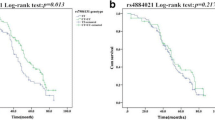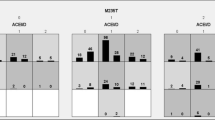Abstract
The signal transduction pathways mediating the progress of heart failure have been intensively studied. Altered signaling of the signal transducers and activators of transcription (STATs), which play important roles in regulating cell proliferation, differentiation, and apoptosis, has been observed in the heart. We conducted a pilot study to test whether single nucleotide polymorphisms (SNPs) in STATs were associated with dilated cardiomyopathy (DCM). Genotypes of two SNPs of STATs (rs6503691 C/T in exon 1 of STAT5B and rs4796793 C/G in the 5′ region of STAT3) in 251 DCM patients and 484 control subjects were determined with the use of PCR–restriction fragment length polymorphism assay and TaqMan assay, respectively. Significantly increased DCM risk was found to be associated with T allele of rs6503691 (P = 0.012, OR = 1.37, 95% CI = 1.07–1.74). We found that increased DCM risk statistically significantly associated with rs6503691 in a dominant model (P = 0.009, OR = 1.50, 95% CI = 1.11–2.04). No association between DCM risk and rs4796793 was observed (P = 0.706, OR = 1.05, 95% CI = 0.83–1.32). The present pilot study provides evidence that both rs6503691 T allele and CT/TT genotypes, but not rs4796793 C/G in the 5′ region of STAT3, are associated with a significantly increased risk of DCM, indicating that common genetic polymorphism in STATs is associated with DCM.
Similar content being viewed by others
References
Watkins H, Ashrafian H, Redwood C (2011) Inherited cardiomyopathies. N Engl J Med 364:1643–1656
Towbin JA, Bowles NE (2002) The failing heart. Nature 415:227–233
Karkkainen S, Peuhkurinen K (2007) Genetics of dilated cardiomyopathy. Ann Med 39:91–107
Richardson P, McKenna W, Bristow M, Maisch B, Mautner B, O’Connell J, Olsen E, Thiene G, Goodwin J, Gyarfas I, Martin I, Nordet P (1996) Report of the 1995 World Health Organization/International Society and Federation of Cardiology Task Force on the definition and classification of cardiomyopathies. Circulation 93:841–842
Towbin JA, Solaro RJ (2004) Genetics of dilated cardiomyopathy: more genes that kill. J Am Coll Cardiol 44:2041–2043
Baig MK, Goldman JH, Caforio AL, Coonar AS, Keeling PJ, McKenna WJ (1998) Familial dilated cardiomyopathy: cardiac abnormalities are common in asymptomatic relatives and may represent early disease. J Am Coll Cardiol 31:195–201
DeWitt MM, MacLeod HM, Soliven B, McNally EM (2006) Phospholamban R14 deletion results in late-onset, mild, hereditary dilated cardiomyopathy. J Am Coll Cardiol 48:1396–1398
Stambader JD, Dorn L, Mikuz G, Sergi C (2010) Genetic polymorphisms in dilated cardiomyopathy. Front Biosci (Schol Ed) 2:653–676
Charron P, Komajda M (2002) Genes and their polymorphisms in mono- and multifactorial cardiomyopathies: towards pharmacogenomics in heart failure. Pharmacogenomics 3:367–378
Zhou B, Rao L, Peng Y, Wang Y, Chen Y, Song Y, Zhang L (2010) Common genetic polymorphisms in pre-microRNAs were associated with increased risk of dilated cardiomyopathy. Clin Chim Acta 411:1287–1290
Hirota H, Chen J, Betz UA, Rajewsky K, Gu Y, Ross J Jr, Muller W, Chien KR (1999) Loss of a gp130 cardiac muscle cell survival pathway is a critical event in the onset of heart failure during biomechanical stress. Cell 97:189–198
Kunisada K, Negoro S, Tone E, Funamoto M, Osugi T, Yamada S, Okabe M, Kishimoto T, Yamauchi-Takihara K (2000) Signal transducer and activator of transcription 3 in the heart transduces not only a hypertrophic signal but a protective signal against doxorubicin-induced cardiomyopathy. Proc Natl Acad Sci USA 97:315–319
Levy DE, Darnell JE Jr (2002) Stats: transcriptional control and biological impact. Nat Rev Mol Cell Biol 3:651–662
Lutticken C, Wegenka UM, Yuan J, Buschmann J, Schindler C, Ziemiecki A, Harpur AG, Wilks AF, Yasukawa K, Taga T et al (1994) Association of transcription factor APRF and protein kinase Jak1 with the interleukin-6 signal transducer gp130. Science 263:89–92
Negoro S, Kunisada K, Fujio Y, Funamoto M, Darville MI, Eizirik DL, Osugi T, Izumi M, Oshima Y, Nakaoka Y, Hirota H, Kishimoto T, Yamauchi-Takihara K (2001) Activation of signal transducer and activator of transcription 3 protects cardiomyocytes from hypoxia/reoxygenation-induced oxidative stress through the upregulation of manganese superoxide dismutase. Circulation 104:979–981
Hirota H, Yoshida K, Kishimoto T, Taga T (1995) Continuous activation of gp130, a signal-transducing receptor component for interleukin 6-related cytokines, causes myocardial hypertrophy in mice. Proc Natl Acad Sci USA 92:4862–4866
Kunisada K, Tone E, Fujio Y, Matsui H, Yamauchi-Takihara K, Kishimoto T (1998) Activation of gp130 transduces hypertrophic signals via STAT3 in cardiac myocytes. Circulation 98:346–352
Podewski EK, Hilfiker-Kleiner D, Hilfiker A, Morawietz H, Lichtenberg A, Wollert KC, Drexler H (2003) Alterations in Janus kinase (JAK)-signal transducers and activators of transcription (STAT) signaling in patients with end-stage dilated cardiomyopathy. Circulation 107:798–802
Ng DC, Court NW, dos Remedios CG, Bogoyevitch MA (2003) Activation of signal transducer and activator of transcription (STAT) pathways in failing human hearts. Cardiovasc Res 57:333–346
Kreil S, Waghorn K, Ernst T, Chase A, White H, Hehlmann R, Reiter A, Hochhaus A, Cross NC (2010) A polymorphism associated with STAT3 expression and response of chronic myeloid leukemia to interferon alpha. Haematologica 95:148–152
Ito N, Eto M, Nakamura E, Takahashi A, Tsukamoto T, Toma H, Nakazawa H, Hirao Y, Uemura H, Kagawa S, Kanayama H, Nose Y, Kinukawa N, Nakamura T, Jinnai N, Seki T, Takamatsu M, Masui Y, Naito S, Ogawa O (2007) STAT3 polymorphism predicts interferon-alfa response in patients with metastatic renal cell carcinoma. J Clin Oncol 25:2785–2791
Vaclavicek A, Bermejo JL, Schmutzler RK, Sutter C, Wappenschmidt B, Meindl A, Kiechle M, Arnold N, Weber BH, Niederacher D, Burwinkel B, Bartram CR, Hemminki K, Forsti A (2007) Polymorphisms in the Janus kinase 2 (JAK)/signal transducer and activator of transcription (STAT) genes: putative association of the STAT gene region with familial breast cancer. Endocr Relat Cancer 14:267–277
Ferguson LR, Han DY, Fraser AG, Huebner C, Lam WJ, Morgan AR, Duan H, Karunasinghe N (2010) Genetic factors in chronic inflammation: single nucleotide polymorphisms in the STAT-JAK pathway, susceptibility to DNA damage and Crohn’s disease in a New Zealand population. Mutat Res 690:108–115
Sookoian S, Castano G, Gianotti TF, Gemma C, Rosselli MS, Pirola CJ (2008) Genetic variants in STAT3 are associated with nonalcoholic fatty liver disease. Cytokine 44:201–206
Zhang L, Kao WH, Berthier-Schaad Y, Liu Y, Plantinga L, Jaar BG, Fink N, Powe N, Klag MJ, Smith MW, Coresh J (2006) Haplotype of signal transducer and activator of transcription 3 gene predicts cardiovascular disease in dialysis patients. J Am Soc Nephrol 17:2285–2292
Finan RR, Mustafa FE, Al-Zaman I, Madan S, Issa AA, Almawi WY (2010) STAT3 polymorphisms linked with idiopathic recurrent miscarriages. Am J Reprod Immunol 63:22–27
Wang K, Zhou B, Zhang J, Xin Y, Lai T, Wang Y, Hou Q, Song Y, Chen Y, Quan Y, Xi M and Zhang L (2011) Association of Signal Transducer and Activator of Transcription 3 Gene Polymorphisms with Cervical Cancer in Chinese Women. DNA Cell Biol. doi:10.1089/dna.2010.1179
Makimura M, Ihara K, Kojima-Ishii K, Nozaki T, Ohkubo K, Kohno H, Kishimoto J, Hara T (2011) The signal transducer and activator of transcription 5B gene polymorphism contributes to the cholesterol metabolism in Japanese children with growth hormone deficiency. Clin Endocrinol (Oxf) 74:611–617
Sole X, Guino E, Valls J, Iniesta R, Moreno V (2006) SNPStats: a web tool for the analysis of association studies. Bioinformatics 22:1928–1929
Jefferies JL, Towbin JA (2010) Dilated cardiomyopathy. Lancet 375:752–762
Ichihara S, Yamada Y, Yokota M (1998) Association of a G994–>T missense mutation in the plasma platelet-activating factor acetylhydrolase gene with genetic susceptibility to nonfamilial dilated cardiomyopathy in Japanese. Circulation 98:1881–1885
Small KM, Wagoner LE, Levin AM, Kardia SL, Liggett SB (2002) Synergistic polymorphisms of beta1- and alpha2C-adrenergic receptors and the risk of congestive heart failure. N Engl J Med 347:1135–1142
Tang LJ, Chen XF, Zhu M, Jiang JJ, Lu XB, Du YX, Wang B, Fang CF, Xue YS, Shen WF (2007) Matrix metalloproteinase-1, -3, and -9 gene polymorphisms and the risk of idiopathic dilated cardiomyopathy in a Chinese Han population. Clin Biochem 40:1427–1430
Darnell JE Jr (1997) STATs and gene regulation. Science 277:1630–1635
Boengler K, Hilfiker-Kleiner D, Drexler H, Heusch G, Schulz R (2008) The myocardial JAK/STAT pathway: from protection to failure. Pharmacol Ther 120:172–185
Fischer P, Hilfiker-Kleiner D (2007) Survival pathways in hypertrophy and heart failure: the gp130-STAT3 axis. Basic Res Cardiol 102:279–297
Jacoby JJ, Kalinowski A, Liu MG, Zhang SS, Gao Q, Chai GX, Ji L, Iwamoto Y, Li E, Schneider M, Russell KS, Fu XY (2003) Cardiomyocyte-restricted knockout of STAT3 results in higher sensitivity to inflammation, cardiac fibrosis, and heart failure with advanced age. Proc Natl Acad Sci USA 100:12929–12934
Yamauchi-Takihara K (2008) gp130-mediated pathway and heart failure. Future Cardiol 4:427–437
Hilfiker-Kleiner D, Hilfiker A, Fuchs M, Kaminski K, Schaefer A, Schieffer B, Hillmer A, Schmiedl A, Ding Z, Podewski E, Poli V, Schneider MD, Schulz R, Park JK, Wollert KC, Drexler H (2004) Signal transducer and activator of transcription 3 is required for myocardial capillary growth, control of interstitial matrix deposition, and heart protection from ischemic injury. Circ Res 95:187–195
Osugi T, Oshima Y, Fujio Y, Funamoto M, Yamashita A, Negoro S, Kunisada K, Izumi M, Nakaoka Y, Hirota H, Okabe M, Yamauchi-Takihara K, Kawase I, Kishimoto T (2002) Cardiac-specific activation of signal transducer and activator of transcription 3 promotes vascular formation in the heart. J Biol Chem 277:6676–6681
Ruppert V, Meyer T (2007) JAK-STAT signaling circuits in myocarditis and dilated cardiomyopathy. Herz 32:474–481
Takemura G, Miyata S, Kawase Y, Okada H, Maruyama R, Fujiwara H (2006) Autophagic degeneration and death of cardiomyocytes in heart failure. Autophagy 2:212–214
Hilfiker-Kleiner D, Limbourg A, Drexler H (2005) STAT3-mediated activation of myocardial capillary growth. Trends Cardiovasc Med 15:152–157
Chen Z, Han ZC (2008) STAT3: a critical transcription activator in angiogenesis. Med Res Rev 28:185–200
Acknowledgments
This work was supported by the National Natural Science Foundation of China (No. 30871044), the Applied Basic Research Programs of Science and Technology Commission Foundation of Sichuan Province (Nos. 2008SZ0174-1, 2010JY0013 and 2010SZ0180), and by Program for Changjiang Scholars and Innovative Research Team in University.
Author information
Authors and Affiliations
Corresponding author
Additional information
Ying Peng and Bin Zhou contributed equally to this work.
Rights and permissions
About this article
Cite this article
Peng, Y., Zhou, B., Wang, Y. et al. Association between polymorphisms in the signal transducer and activator of transcription and dilated cardiomyopathy in the Chinese Han population. Mol Cell Biochem 360, 197–203 (2012). https://doi.org/10.1007/s11010-011-1057-1
Received:
Accepted:
Published:
Issue Date:
DOI: https://doi.org/10.1007/s11010-011-1057-1




